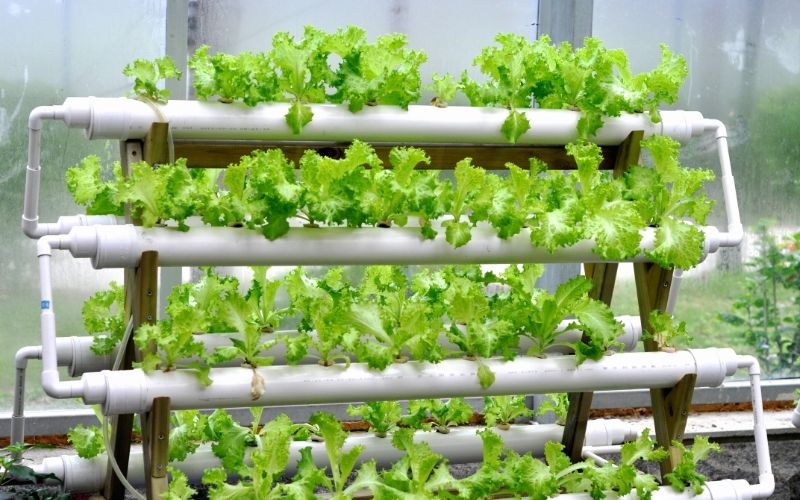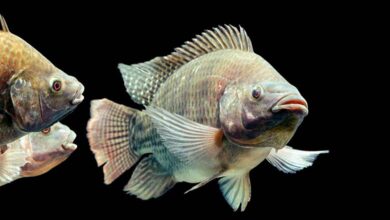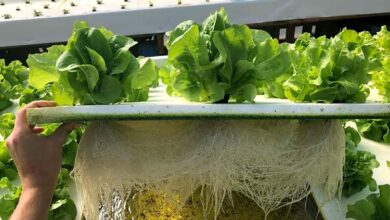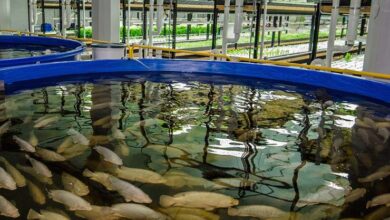
The majority of human beings desire to have a nice green space in their home, balcony, or roof. However, there is no better concept than establishing an aquaponics system where you can both enjoy and collect food.
You will know about the four major types of aquaponics systems, which we shall cover further below. The article will go through the procedure and how it works, as well as the benefits, advantages and disadvantages, and much more. It will assist you in making decision for selecting what design you will create. Let’s find out more about these aquaponics technique.
A. Media Based Aquaponics System:
The most common aquaponics system is the Media Based, or Flood and Drain, which employs a grow bed or container filled with grow media (typically gravel, lava rock, or clay pebbles) to plant the crops. A bell siphon periodically floods the grow bed with water from the fish tank so that the plants may receive the nutrients. Water is cycled from the fish tank to the grow bed, where bacteria and plants take nutrients from the effluent. As a result, the cleaned water is returned to the fish tank and aerated. The medium in media bed units is used to support the roots of the plants. Rectangular media beds can be constructed with a plastic, fiberglass, or hardwood frame and water-tight rubber or polyethylene sheets on the base and inside the walls.
- Pros:
There is no additional filtering; the same medium serves as a mechanical and biological filter. It is appropriate for a wide range of plants, from leafy greens to bigger fruiting plants.
- Cons:
Over time, the pore spaces in the medium may become clogged, resulting in poor anaerobic conditions for your plants. As a result, the grow bed may need to be cleaned. Due to decreased productivity, an expensive medium, and the difficulty of large-scale application, this method is not usually suitable for commercial purposes.
B. Raft System:
Rafts, also known as deep water culture or simply DWC, are commonly found in commercial systems. A raft system circulates nutrient-rich water down lengthy canals, usually at a depth of approximately 20 cm, while rafts (polystyrene or foam board) float on top. Plants are planted on raft boards that are supported within holes by net pots. Plant roots dangle in nutrient-rich, oxygenated water, absorbing oxygen and nutrients while they grow fast. The nutrient-rich water continuously flows from the fish tank via the filtration process. Then to the plant-growing raft tank, and finally back to the fish tank.
- Pros:
This method is used by many commercial aquaponics farms because it allows plants to grow faster and produce more harvests. Because it is a low-cost method, it is ideal for home gardens, hobby uses, and commercial production. The roots are more exposed to nutrient-rich water. Plants are easier to harvest since their roots are immersed in water rather than any other medium. The volume of water in a raft system ensures that it is more stable in terms of water quality and temperature than other systems. Simple upkeep because raft beds are simple to clean. It enables more fish stocking.
- Cons:
Because it requires filtration and aeration, the cost will rise. Beneficial bacteria cannot grow optimally there, but mosquitos can. It can only grow little leafy greens like lettuce and basil.
C. Nutrient Film Technique (NFT):
The grow tray (or channel) where plant grow and the reservoir containing water and nutrients where fish culture are the two primary components of the NFT system. There are net pots in the grow tray that hold the growing media (perlite, coconut, Rockwool) and reserve nutrients from the fertilizer solution. A pump delivers water to the grow tray, and a drained line recycles the unneeded water fertilizer solution. Plant roots dangle to the bottom of the channel, where they come into contact with the nutrient solution’s shallow layer and absorb nutrients from it. The nutrient solution’s thin coating allows the plants to be watered but not completely drenched. This thinness also helps the upper part of the roots to stay dry while yet having access to oxygen in the air. The roots clean and filter the water before it returns to the fish tank. When water enters the fish tank, it overflows via the exit pipe and back into the mechanical filter, completing the cycle.
- Pros:
Because half of the root is visible, the roots get plenty of oxygen, which helps avoid root rot. Constant flow of water decreases fungus danger and promotes plant and fish growth and health.
- Cons:
The roots have the potential to obstruct the passageways. The temperature of the water can change quickly. Pump failure can wreak havoc on yield. Large plants with huge root systems do not do well in an NFT system, but leafy greens and tiny vegetable plants do.
D. Vertical Aquaponics System:
One aquaponics technology is vertical aquaponics, which grows plants without soil in columns above the fish tank. The nutrient film technique (NFT) aquaponics approach is primarily used. The sole difference is that the developing channels in the NFT approach are horizontal, whereas the expanding channels in the vertical system are vertical.
- Pros:
This can extend your growth space without requiring additional floor space. This can be an appealing alternative if you have limited space inside or outside your home. The key to a successful vertical aquaponics system is to allow enough space for each plant to thrive and receive appropriate light while limiting plant spacing. The advantage of vertical towers is that crops can successfully grow over each other.
- Cons:
The narrow tubes or pipelines are prone to clogging. When the pump fails, the roots may be deprived of water. It is only good for little rooted plants.
Each of these aquaponics system ideas could be the greatest aquaponics system design for you to use in a specific situation. When deciding on the sort of system to develop, it is critical to examine the benefits and drawbacks of each design to choose which best meets your demands and capacity. In aquaponics, maintaining a healthy balance of fish, bacteria, and plants is critical. Once you have achieved a good balance, you’ll have a successful and long-lasting aquaponics system design on which to rely.
Farhana Islam
Agriculturist, Researcher



